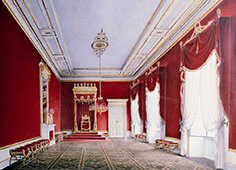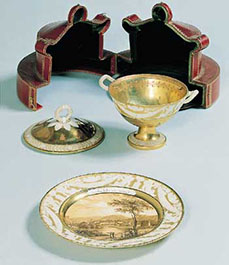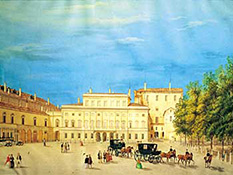The Gold Room
The room is characterized by the splendid vault designed in about 1764 by Petitot and decorated by Benigno Bossi with refined gilded plaster.
The magnificence experienced by Marie Louise at the Court of Napoleon is suggested by a number of precious objects in the showcases, such as the centerpiece in crystal and vermeil and the great clock with figures of the arts designed along neat, neoclassical lines by the famous Thomire and Odiot, or the precious birthing cup made by Dagoty and given by Napoleon to his young bride on the occasion of the birth of their son. Bonaparte’s military campaigns are evoked by the trunk for his camp-bed, signed by the refined goldsmith Biennais; two small and exquisite drawings show Letizia Ramolino, the Emperor’s mother, and his sister Paolina, known for her beauty, respectively portrayed by Isabey and Canova.
Six lovely watercolours painted by Giuseppe Naudin in the 1830’s offer charming details of the inside of Parma Palazzo Ducale, where Marie Louise (at this time better known as Maria Luigia) used to live. The palace was located in front of the building which now hosts the Museum, and was connected to it by means of an arcaded walkway which straddled the streets. Two paintings by Alinovi and Mazza show the palace facade, designed by Nicola Bettoli, the Court architect who was in charge of the redevelopment plan for all public buildings; the Ducal palace was severely damaged by a bomb in 1944 and was demolished immediately after the war.
Other oil paintings and watercolours depict the country mansions of the Duchess (namely Colorno and Sala) and a number of views of her States. Portraits of relevant political and artistic characters from the time are also displayed, amongst whom can be seen Madame Récamier, the sculptor Antonio Canova, the dancer Maria Taglioni and the singer Lucrezia Agujari.
A fine collection of gold medals commemorates some of the many public monuments Maria Luigia left in Parma, among which a new Court Theatre which is now known worldwide as the Teatro Regio; sketches for the two curtains are here displayed, one of them identifying the goddess Minerva, protector of the Arts, with the Duchess, who was really devoted to art and culture.













